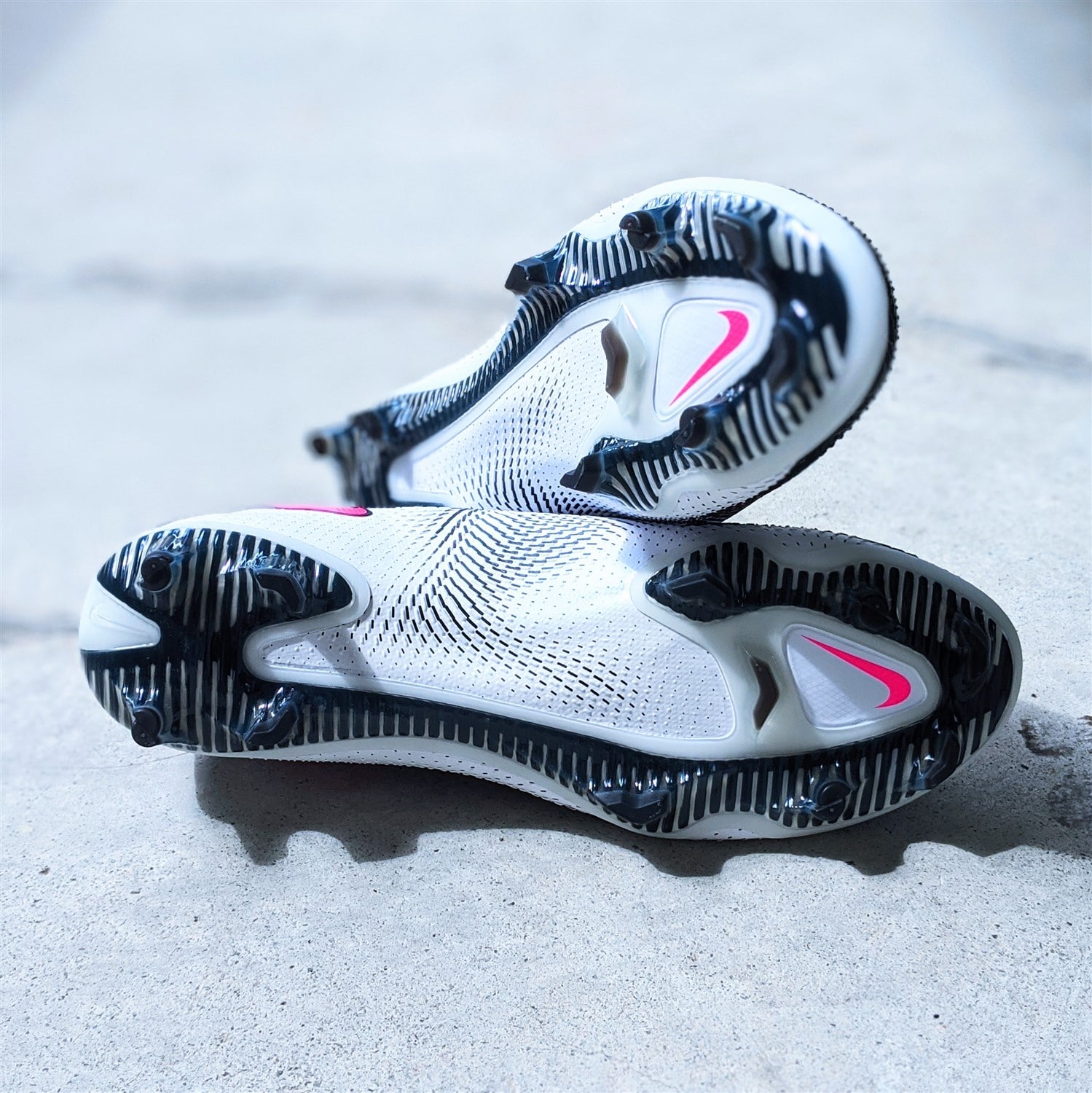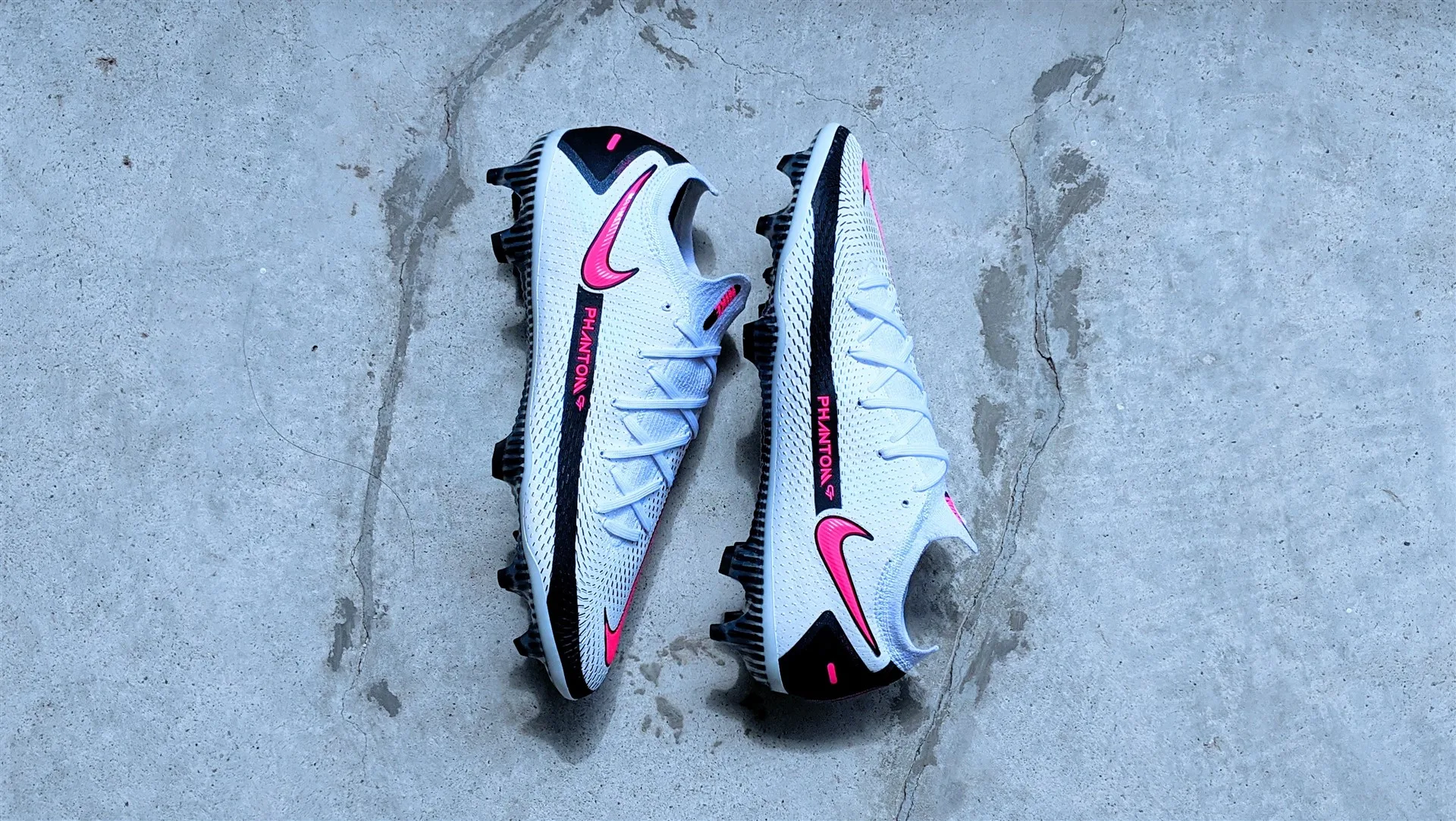The Nike Phantom GT reimagines an old favourite for a new generation.
I’ll be honest, despite being a huge fan of the PhantomVSN, I’ve always found the idea of having 2 boots in the Phantom silo confusing. Although the boots had similar sounding names, VSN and VNM, they had different unique selling points (USP). The VSN focused on a clean and natural touch, with a lace cover for “zero distractions”. The VNM on the other hand, saw the return of shot enhancing technology, last seen on the T90 Laser series.
While we loved the PhantomVSN, going as far as to rate it as his 2018 boot of the year, it never really caught fire among consumers, perhaps due to how it looked. While the VNM was a better looking product, the shot shield element never felt aggressive enough, unlike the ones on the T90 Lasers or the 2020 Predators.
Enter the Nike Phantom GT, which replaces both Phantoms, and reduces Nike’s silo range to a trio.

Goodbye Phantom VSN & VNM, Hello Phantom GT
While the Phantom GT undoubtedly carries elements of both boots, the boot that it resembles most goes all the way back to 2013, the much beloved Nike Hypervenom Phantom 1. In fact, I’d go as far as to suggest that the boot is a proper successor to the Hypervenom 1 and carries much of its DNA – barefoot touch, comfortable fit and grip – in it.
The Phantom GT, strips away much of what we saw on the VSN and VNM. Gone is the Quadfit mesh that we really loved in the VSN, the corrective shot shield technology of the VNM has also disappeared and surprisingly, so is the lace cover. The Phantom GT is a very basic boot. It features a textured Flyknit upper (called Generative Texture, GT for short) for grip on the ball and off-centre laces for a clean strike zone.

The only bit of new innovation you find comes from the soleplate, where Nike have taken learnings from the Mercurial’s split sole design to create a semi-split soleplate. The soleplate in the instep are has been removed to emphasize the arch and provide a more “free” sensation when contacting the ball with that part of the foot. The boot does feel very alien to Nike, lacking that the sort of eye-catching new technology that we’ve come to expect from a new Nike silo.
Widest fit in the market
On feet, the first thing that hits you is just how wide the Phantom GT is. They’re probably the widest boot on the market now, especially with the semi-split soleplate design giving you even more space for the arch.
As a flat-footed player, this was a welcome change as my arch has space to sink into. I loved how free my foot felt, with little pinch points, much like how the Hypervenom 1 felt. However, the lack of Quadfit or Flywire system means that you do feel the midfoot giving way when making aggressive turns. It’s nowhere as bad as what it was on the Hypervenom 1, but it’s definitely one of the least responsive football boots Nike has developed in awhile.

An important point to note as well is that while they both look the same, both the black and white colourways from launch actually fit differently. We tested both variants in stores and also checked with other reviewers and can confirm that the white colourway actually has a wider and sloppier fit as compared to the black colourway. I went true to size with the black colourway but in the white version I suffered from blisters due to the higher volume toe box and had material bunch up on the side of my foot.
If you have very wide feet, do consider going true to size in the white colourway. If you’ve got an average to narrow foot, I recommend going half size down in the black colourway.
Thanks to the upper being just a single layer of Flyknit, the touch on the ball feels extremely barefoot. I’d venture as far as to say that it’s even thinner than the Mercurial series, which uses a fairly thick weave of Flyknit. You feel every strike of the ball, every ping, and it’s one of those boots that makes you keep wanting to take shots and blast the ball into the top corner all the time.
What I particularly enjoyed about shooting in the Phantom GT was the semi-split sole construction. I felt that my freed-up arch had better contact with the ball and let me wrap my foot around the ball more sweetly which meant that I was able to whip in those Beckham-esque crosses or place shots into the top corners much more easily. Top marks for that.

Unaggressive texturing
While Nike’s focused most of their marketing on the Generative Texture, it was probably the least effective performing feature of the boot. While I wasn’t expecting it to be as aggressive as the Demonskin spikes on the adidas Predator, I was looking forward to an experience akin to the sandpaper-like texture on the Phantom VSN series.
For me, the VSN silo had the perfect balance of grip, enough friction to enhance your ability while performing tricks such as the elastico, but not too much clingthat you needed time to get used to the excessive grip when dribbling.

Unfortunately, the Phantom GT’s texturing doesn’t quite achieve what it sets out to do. Sure, the texturing helps to break apart water droplets on the surface to give you better grip in wet situations. However, in dry conditions, its effects are less obvious.
Freedom to move in the Phantom GT
We’ve been fairly critical of Nike for having overly aggressive FG plates that are not AG friendly. I used to encounter knee issues after using the VSN FG plate on AG, despite them being fairly conical. I’m more than happy to announce that the GT marks a welcome return to an AG-friendly Nike FG plate, and gets the BOOTHYPE stamp of approval for AG use.

While the studs are mixed with both “split” conical and bladed studs, the bladed studs are placed in areas associate with pushing off when making hard aggressive movements laterally or vertically.
This means that you get the best of both worlds – nice rotational movement when twisting and pivoting, as well as a nice bite when toeing off, both forward and sideways when you drop your shoulder to leave the defender for dead. I’m not convinced that the “split” conical studs actually do anything, but they didn’t get in the way.
A barefoot future
When Nike retired the T90 Laser 4 with its aggressive shot elements for an extremely minimal and barefoot silo in the Hypervenom 1, I was surprised and wondered if it’d flop considering how different it was from its predecessors. It didn’t help that it was fairly similar to the Vapor – another thin, lightweight boot. With hindsight, Nike clearly knew what the market wanted, considering how the Hypervenom 1 has now become a cult classic, with many still rating it as the boot of the decade.

Today, we have a similar situation, with the shot shield enhanced VNM and the Ghost Laced VSN replaced by the more minimalist Phantom GT. While I enjoyed my time in the Phantom GT, the boot feels like a step back, especially when we’re talking about that upper. Its predecessor, the Phantom VSN 2 offered a fairly barefoot-like experience without compromising responsiveness (thanks to Quadfit) and grip on the ball. Having said that, I did enjoy the new semi-split sole and studs, which was probably the biggest bright spot of the boot.
To me, the Phantom GT feels like Nike is taking a conservative step back to re-assess what consumers want in 2020, before attempting to change the game again with the next iteration. Just make sure you bring back that awesome semi-split sole and stud configuration too, Nike.




